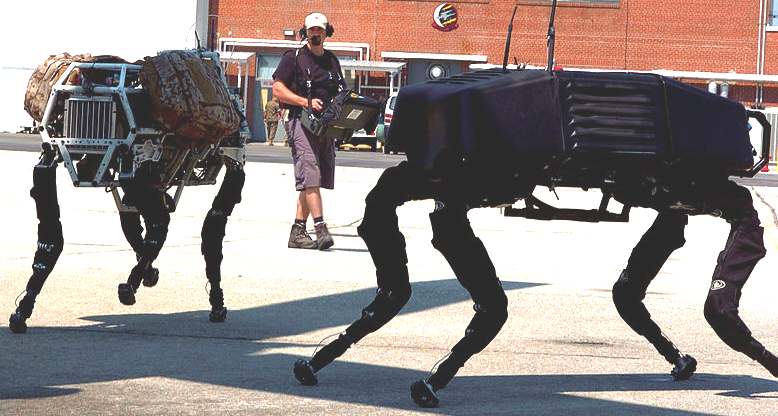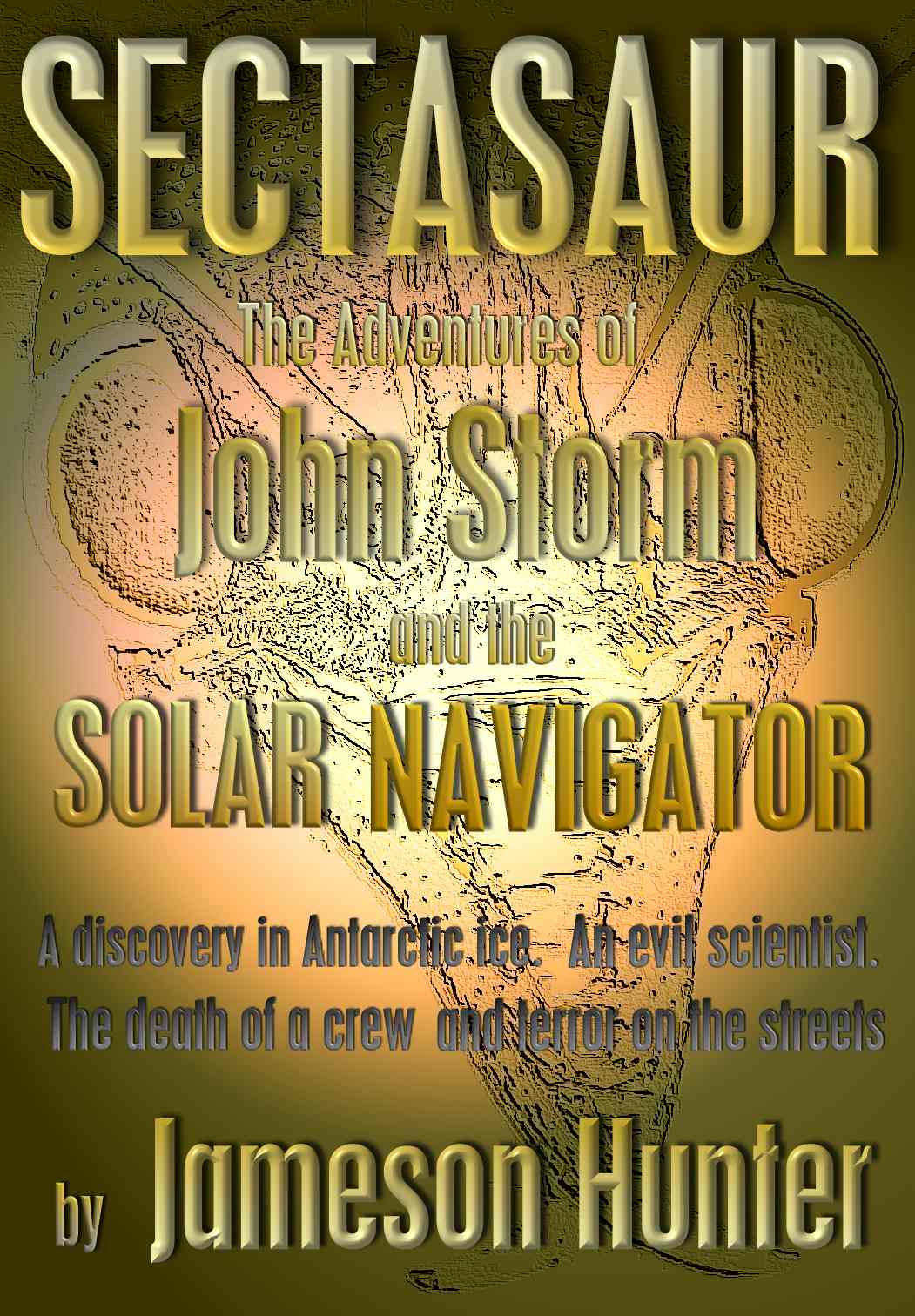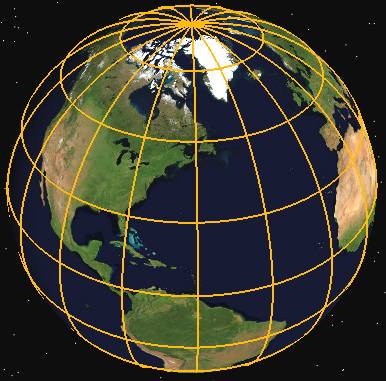|

BIG
DOG - DARPA
BigDog is a dynamically stable quadruped robot created in 2005 by Boston Dynamics with Foster-Miller, the NASA Jet Propulsion Laboratory, and the
Harvard
University Concord Field Station. BigDog is 3 feet (0.91 m) long, stands 2.5 feet (0.76 m) tall, and weighs 240 pounds (110 kg), about the size of a small mule. It is capable of traversing difficult terrain, running at 4 miles per hour (6.4 km/h), carrying 340 pounds (150 kg), and climbing a 35 degree incline. Locomotion is controlled by an onboard
computer that receives input from the robot's various sensors.
Navigation and balance are also managed by the control system.
BigDog is funded by the Defense Advanced Research Projects Agency (DARPA) in the hopes that it will be able to serve as a robotic pack mule to accompany soldiers in terrain too rough for conventional vehicles. Instead of wheels or treads, BigDog uses four legs for movement, allowing it to move across surfaces that would defeat wheels. The legs contain a variety of sensors, including joint position and ground contact. BigDog also features a laser gyroscope and a stereo vision system.
BigDog's unique walking pattern is controlled through four legs, each equipped with four low-friction hydraulic cylinder actuators that power the joints. "The BigDog robot, labelled as a military robot mule, has subsequently proven its potential worth in its ability to reduce load and remove that burden from a soldier's back."
Built onto the actuators are sensors for joint position and force, and movement is ultimately controlled through an onboard computer which manages the sensors.
Approximately 50 sensors are located on BigDog. These measure the attitude and acceleration of the body, motion and force of joint actuators as well as engine speed, temperature and hydraulic pressure inside the robot's internal engine. Low-level control, such as position and force of the joints, and high-level control such as velocity and altitude during locomotion, are both controlled through the onboard computer.
BigDog was featured in episodes of Web Junk 20 and Hungry Beast, and in articles in
New Scientist, Popular Science, Popular Mechanics, and The Wall Street Journal.
On March 18, 2008, Boston Dynamics released video footage of a new generation of BigDog known as AlphaDog. The footage shows BigDog's ability to walk on icy terrain and recover its balance when kicked from the side.
The refined equivalent has been designed by Boston Dynamics to exceed the BigDog in terms of capabilities and use to dismounted soldiers.
In February 2012, DARPA, which has continued to support the programme, carried out the first outdoor exercise on the latest variation of the LS3 with it successfully demonstrating its full capabilities during a planned hike encompassing tough terrain.
Following the success, an 18-month plan has been unveiled, due to start the summer of 2012, which will see DARPA complete the overall development of the system and refine its key capabilities, ensuring its worth to dismounted warfighters before it is rolled out to squads operating in theatre. The BigDog must be able to demonstrate its ability to complete a 20 mi (32 km) trek within 24 hours without refuelling while carrying a load of 400 lb (180 kg), whereas a refinement of its vision sensors will also be conducted.
At the end of February 2013, Boston Dynamics released video footage of a modified BigDog with an arm. The arm can pick up objects and throw them. The robot is relying on its legs and torso to help power the motions of the arm. The news writer supposed it can lift weighs in the 50 pounds (23 kg) range.
Hardware
Big Dog is powered by a two-stroke, one-cylinder, 15-HP go-kart engine operating at over 9,000 RPM. The engine drives a hydraulic pump, which in turn drives the hydraulic leg actuators. Each leg has four actuators (two for the hip joint, and one each for the knee and ankle joints), for a total of 16. Each actuator unit consists of a hydraulic cylinder, servovalve, position sensor, and force sensor.
Onboard computing power is a ruggedized PC/104 board stack with a Pentium 4 class computer running QNX.
Robots
are working all over the world almost every day to make
the lives of humans easier. Since the advent of
microprocessors and computers, the possibilities for
Robots to improve our civilisation are that much more. We
already have robot factories churning out cars to a
higher standard, than those produced in manned
factories. Simple domestic robots are finding
their way onto the market to relieve us of tedious
tasks. This is sure to mean more complex robots
will be designed and become cheaper, to in turn, free
humans more and more from everyday chores. Put
this emerging technology together with renewable energy,
such as solar cells, and the possibilities are
endless. Not only could the world rely on
plentiful renewable energy, but we'd have more time to
devote to other problem areas in our society. We
could build a higher society where food, energy,
healthcare and transport are available to
all.
LINK
and REFERENCE
BigDog
- The Most Advanced Rough-Terrain Robot on Earth Boston Dynamics.
Retrieved 2009-06-22.
DARPA’S
LS3 AlphaDog begins outdoor testing
Video
of BigDog in action from Boston
Dynamics
BigDog
Throws Cinder Blocks with Huge Robotic Face-Arm 28 February 2013.
BigDog
Overview Boston Dynamics. November 22, 2008.
Boston
Dynamics's BigDog page
Boston
Dynamics Big Dog (video March 2008)
Could
BigDog be a soldier's best robotic friend?

Lurking
beneath the Antarctic ice is a discovery that scientist will die for.
BIPEDS
| CYBEE
| HEXAPODS | MANTIS
| OCTOPODS
QUADRUPEDS
| ROBOBEE
| ROBOT
ANT | SPIDERBOT
| STOMPY | TRIPODS
.......
The World in Your Hands
|

